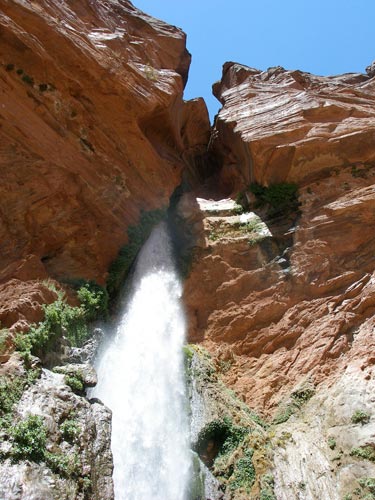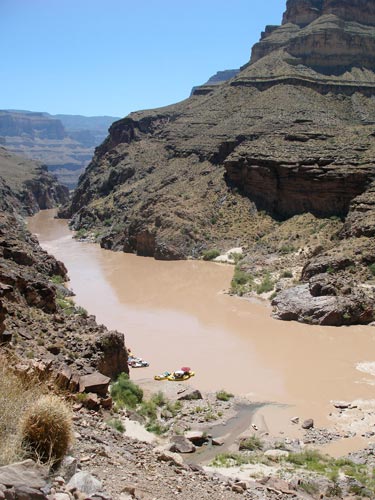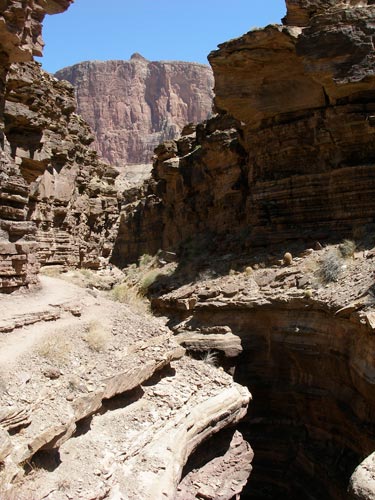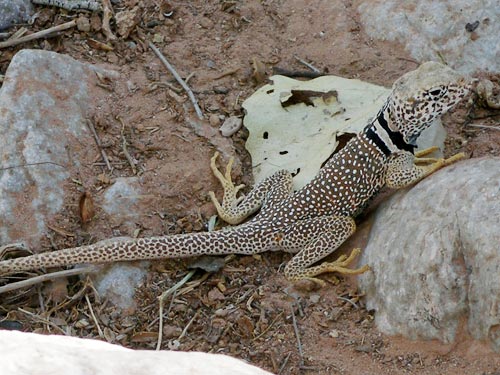Sand is constantly in everything and things are all stained brown. It was excruciatingly hot last night and I also got bit by a red ant. We ate, packed up and got back on the river. The day was a real scortcher!

At mile 135 is the Granite Narrows, the river's narrowest spot at only 76 feet wide. It is also the deepest pool in the river.


A Desert Bighorn Sheep watches us float past.

One way to keep cool. Note how his white shirt is starting to look brown!

Water wars!
We made a stop at Deer Creek. Lower Deer Creek Falls (near mile 136) is a thunderous 90-foot waterfall that bursts from the cliff face.


The water was clear and cool, and the pool was fairly deep.

The spray at the bottom was so strong, that it was impossible to swim directly in front of it.
I tagged along on a hike up along Deer Creek. It took us along some narrows and eventually to the source of the river where it came out of a cliff.

Deer Creek enters the Colorado River.

The Deer Creek Narrows can be hiked along from above or from below.

Looking down into the narrows, an impressive Tapeats Sandstone slot canyon


A ceiling full of worm trail fossils

A pictograph of a hand
Pictographs are paintings usually found on light-colored sandstone. The paints are made from various plant parts and possibly animal fat. They could be applied with fingers, hair or plant fiber brushes. Hollow bird bones could also be filled with the paint and sprayed around an object.
In contrast, petroglyphs are carvings often found on rocks with desert varnish (the dark coating that builds up on rocks exposed to the desert elements for a long time). Scraping off the varnish with a sharp stone reveals the original lighter rock color underneath.

A branch with leaves

Here is still more evidence of the people who used to inhabit this area.

The Throne Room (tourist-made rock chairs and furniture) is largely deteriorated and not what it once was.

Me standing behind Deer Spring, the source of the river. Deer Spring is much smaller than Thunder River but still quite lovely.

The backside of water

A Collared Lizard
Collared Lizards are members of the iguana family (Iguanidae). Their tails do not detach easily and do not grow back as in other lizards of this family. They are one of the few desert lizards who can run on their two hind legs (bipedal locomotion). Their favorite prey is other lizards but they also eat a large variety of invertebrates.

Amazing but true, seemingly delicate tadpoles thrive in this harsh climate.
Night fell at Matkat (Matkatamiba) Camp. There is the constant roar of the river but it is otherwise quiet. There are almost no cicadas here and only the occasional bird call in the canyon. The rocks radiated the heat, so I slept on one of the rafts. At least there is a cool breeze that sometimes comes off the water. In the middle of the night, we got a surprise visitor....
One of the most active, unseen animals is the ringtail cat (actually a member of the raccoon family and not a cat). They would often raid the rafts at night. This time, they managed to get into the drop box directly under us and eat two apples. They make little chirping noises and leave lots of footprints.

Some Johnny Cash songs
return • continue

